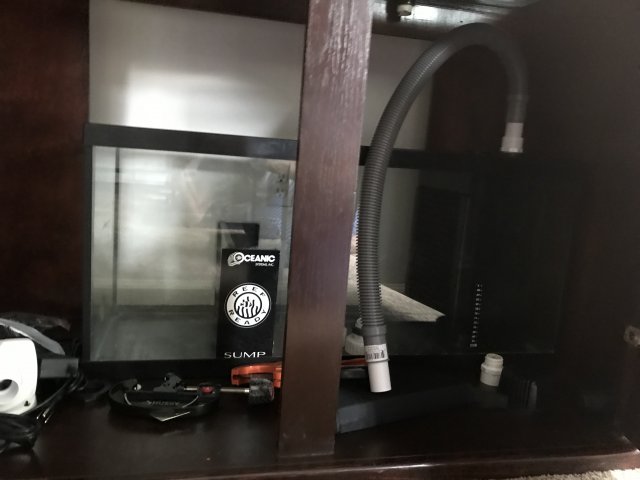So I'm currently working on getting a 120 gallon aquarium (48"x24"x24") set up. It has a 30 gallon (36"x12"x16") sump which is currently set up in a rather underwhelming fashion. My current plans for drainage are as follows: the system will drain via two "megaflow" style overflows tied together behind the tank with a 2" balance pipe. I intend to use a bean animal style drain with 1 full siphon standpipe in the far (left) overflow, 1 open channel (durso-style) standpipe in the near (right) overflow, and an additional backup drain plumbed through the back of the overflows. My goal is to circulate 720 gallons per hour between the sump and display tank, though I'd be open to going with lower or higher turnover rates if that made for better filtration.
The issues with this setup start once the water reaches the sump (pictured below) however. As you can see it's set up for a wet/dry filter, with water dropping straight out of the hoses onto a trickle plate. From what I understand, that's a recipe for an extremely loud filter, and considering this is going in an apartment with neighbors who would potentially be bothered by load gurgling and splashing audible through the walls, I need to make this system quiet. I'm planning on using it for freshwater, but would like keep the option to convert to saltwater open.
One person on reddit suggested converting the sump to use a fluidized bed filter. My own impression is that such systems are by far the loudest out of the various filtration schemes, but maybe I'm missing something; could I substitute (loud) air pumps and bubbles for (comparatively silent) circulation pumps, or would that not work. In order to keep the noise of splashing water down, I'll need to install extensions to the drain pipes that go below the water level in the first chamber (and add in a bunch of new baffles), so I would assume that rules out a wet/dry filter, and at the same time I'm concerned that simply running submerged media in the sump will be ineffective; the denizen of the tank I'm planning for will be a decently large and messy eater.
I'm grateful for whatever advice the community here at MFK can offer.

The issues with this setup start once the water reaches the sump (pictured below) however. As you can see it's set up for a wet/dry filter, with water dropping straight out of the hoses onto a trickle plate. From what I understand, that's a recipe for an extremely loud filter, and considering this is going in an apartment with neighbors who would potentially be bothered by load gurgling and splashing audible through the walls, I need to make this system quiet. I'm planning on using it for freshwater, but would like keep the option to convert to saltwater open.
One person on reddit suggested converting the sump to use a fluidized bed filter. My own impression is that such systems are by far the loudest out of the various filtration schemes, but maybe I'm missing something; could I substitute (loud) air pumps and bubbles for (comparatively silent) circulation pumps, or would that not work. In order to keep the noise of splashing water down, I'll need to install extensions to the drain pipes that go below the water level in the first chamber (and add in a bunch of new baffles), so I would assume that rules out a wet/dry filter, and at the same time I'm concerned that simply running submerged media in the sump will be ineffective; the denizen of the tank I'm planning for will be a decently large and messy eater.
I'm grateful for whatever advice the community here at MFK can offer.



